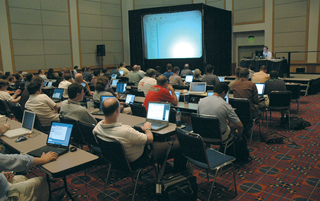
By Michael Schilli
O'Reilly's yearly Open Source Conference attracted 2100 registrants to Portland, Oregon USA on August 1-5. This year the conference was held at a new conference center, since OSCON has outgrown previous locations. Vendors like Google, Yahoo!, and Hewlett Packard reported in presentations and keynotes on how they are using Open Source and contributing back to community projects. Many of these vendors were hiring new employees and were busily collecting resumes at the exhibition hall.
Along with more traditional topics, such as Perl, Apache, MySQL/PostgreSQL,Subversion, PHP, Java, Python, and Open Source legal business, another more unusual topic proved surprisingly popular: the programming language Ruby, especially its rapid Web development framework, Ruby on Rails, captivated many and raked in one of the $5000 Open Source awards.
Key developer David Heinemeier Hansson presented the secret of Rails' success: instantly visible changes, complete ownership of the entire application stack (without relying on external frameworks), and the "Convention over Configuration" mantra, using liberating constraints instead of daunting configuration tasks, aptly named "XML situps."
Additional Open Source awards went to Doc Searls (communication), Jeff Waugh (evangelism, Ubuntu, and Gnome), Geir Magnusson Jr. (diplomacy, Apache) and Richard Hipp (integrator, SQLite). White camel awards went to Stas Bekman (mod_perl world tour), Eric Cholet (Perl mailing list moderation), and Andy Lester (Perl testing with Phalanx).
Conference heads Tim O'Reilly and Nathan Torkington envisioned what the next revision of the Internet, "Web2.0," could look like. Their vision for the new Web includes Web applications using foreign content like Google Maps as an underlying platform for content integration, client side GreaseMonkey hackery to beat unsuitable Web sites into shape, and auto-learning personalized content aggregators like findory.com.
Novell's Miguel de Icaza pointed out that developers who care about Open Source should help improve the Linux desktop instead of relying on Apple's closed source OS X GUI. This was blatantly visible at the conference, where Apple laptops dominated. With its upcoming "Open SUSE" release, Novell will introduce easier desktop rendering based on XGL (an X11 implementation on top of OpenGL), Gnome applications running on a hardened Mono platform, and an improved desktop search ("Beagle") to combat Apple's Spotlight. Novell's internal Windows to Linux migration is reportedly 50% complete.
No one had any exciting news on Perl6: co-designer Damian Conway announced the "Endgame," with the designs, the Perl6 virtual machine, and the compiler close to completion, but again, no target date was announced. Autrijus Tang's alternative Perl 6 compiler PUGS, implemented in Haskell, will help testing and get developers up to speed long before everything else is complete.
Finally, there is good news for European Open Source enthusiasts dreading the long journey to Portland: a new OSCON Europe show will take place in Amsterdam, October 17-20, 2005.